Customer Experience: Your Basic Starter’s Guide
Great customer experience management necessitates a customer-centric mentality...and a lot of meticulous work.
However, fret not, will teach you why CX is essential, how to enhance it through customer feedback and surveys, as well as suggestions from 100+ CX professionals and a report with plenty of CX trends and stats.
Basically, everything you need to start providing an amazing experience for your customers. So, without further ado, let’s do further and get cracking with the basics:

What is customer experience?
Customer experience, or CX, is your consumers' overall view of their interaction with your company or brand.
CX is the outcome of every engagement a consumer has with your company, from navigating the website to contacting customer support and receiving the product/service they purchased from you. Everything you do influences your customers' perceptions and their decision to return or not, thus providing an excellent customer experience is critical to your success.
That said, why then is customer experience management important?
Importance of CX
Providing an excellent client experience is critical for every organisation. The better the customer experience, the more recurring business and great evaluations you'll receive, while also minimising the friction of customer complaints and returns.
The advantages of providing excellent customer service include:
-
Increased customer lifetime value
-
enhanced customer loyalty
-
enhanced client satisfaction
-
improved word-of-mouth marketing, favourable reviews, and recommendations

Improving the customer experience may benefit all company models: subscription firms can enhance retention and minimise churn, ecommerce marketplaces can promote repeat business and reduce returns, and service sectors can earn recommendations and reduce complaints.
In fact, we dare you to conceive of a firm that does not profit from a positive client experience. We think that putting the consumer first is always beneficial to the company.
Here’s a quick survey conducted in 2018 of over 2000 CX professionals encompassing points about customer experience strategies, methods, goals, obstacles, and so on which we are more than happy to list here.
We asked respondents to categorise themselves into one of four categories to acquire more relevant insights into the results: ignorant, novice, competent, and mature.
Ignorant - These are businesses that do not see customer experience as a key difference. There are no efforts to create a CX strategy or measure CX projects.
Novice - These are businesses who appreciate the need of improving the customer experience. They've taken basic measures to identify and measure customer experience concerns, but they don't have a comprehensive CX plan in place.
Competent - These businesses make an effort to provide their clients with a high-quality experience. They have a defined CX strategy in place, as well as systems in place to monitor success.
Mature - These are the crème of the crop in terms of customer experience. Their CX approach pervades all they do. Customer input is important to their strategy and decision-making, and they iterate their CX methods regularly to satisfy customer demand.
Note that only 12% of organisations consider themselves Mature CX companies, whereas 38% consider themselves Young, 40% as First Steps, and 10% as Ignore.
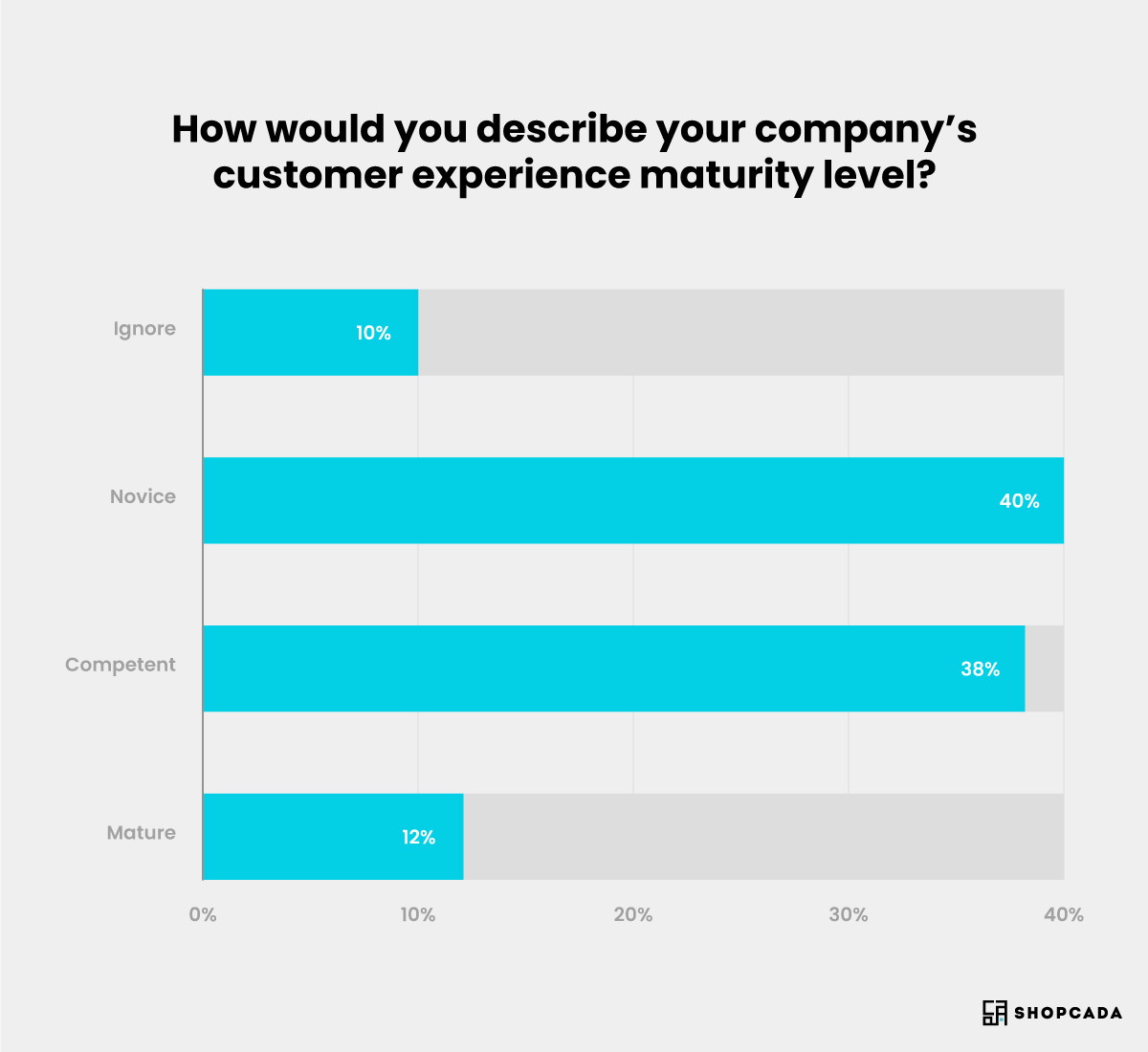
We noticed that by categorising organisations in this way, CX leaders reported much greater sales than their rivals. In fact, 42% of Mature firms have yearly revenue of more than $100 million, whereas nearly half of ignored companies have annual revenue of less than $1 million.
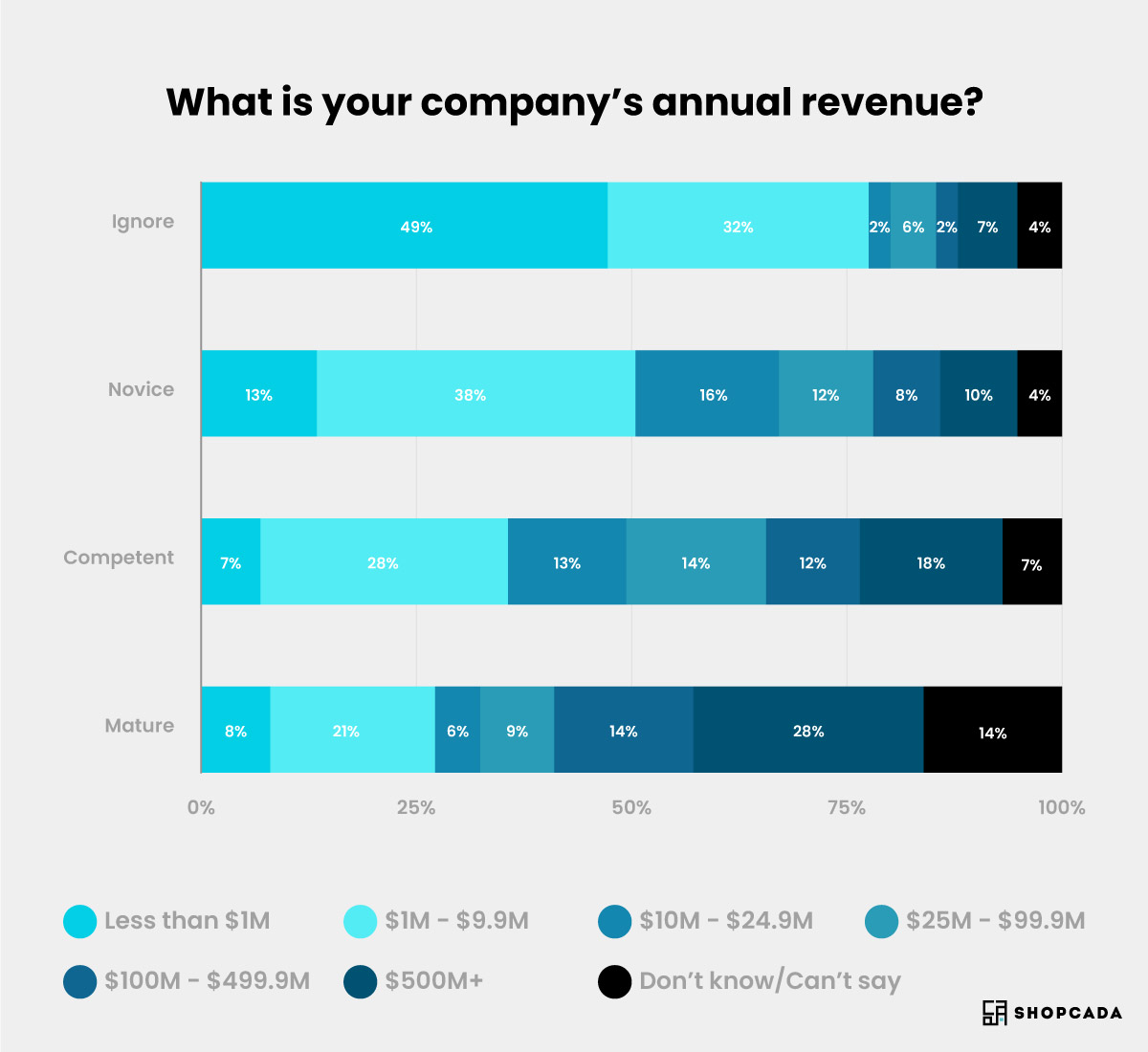
But that's not all—mature businesses also have very defined goals and tried-and-true techniques for implementing a successful CX strategy. Here's what more we found out:
CX leaders focus on providing an exceptional experience above everything else
Hands down, mature businesses are more concerned with providing the best possible experience than with boosting their bottom line.
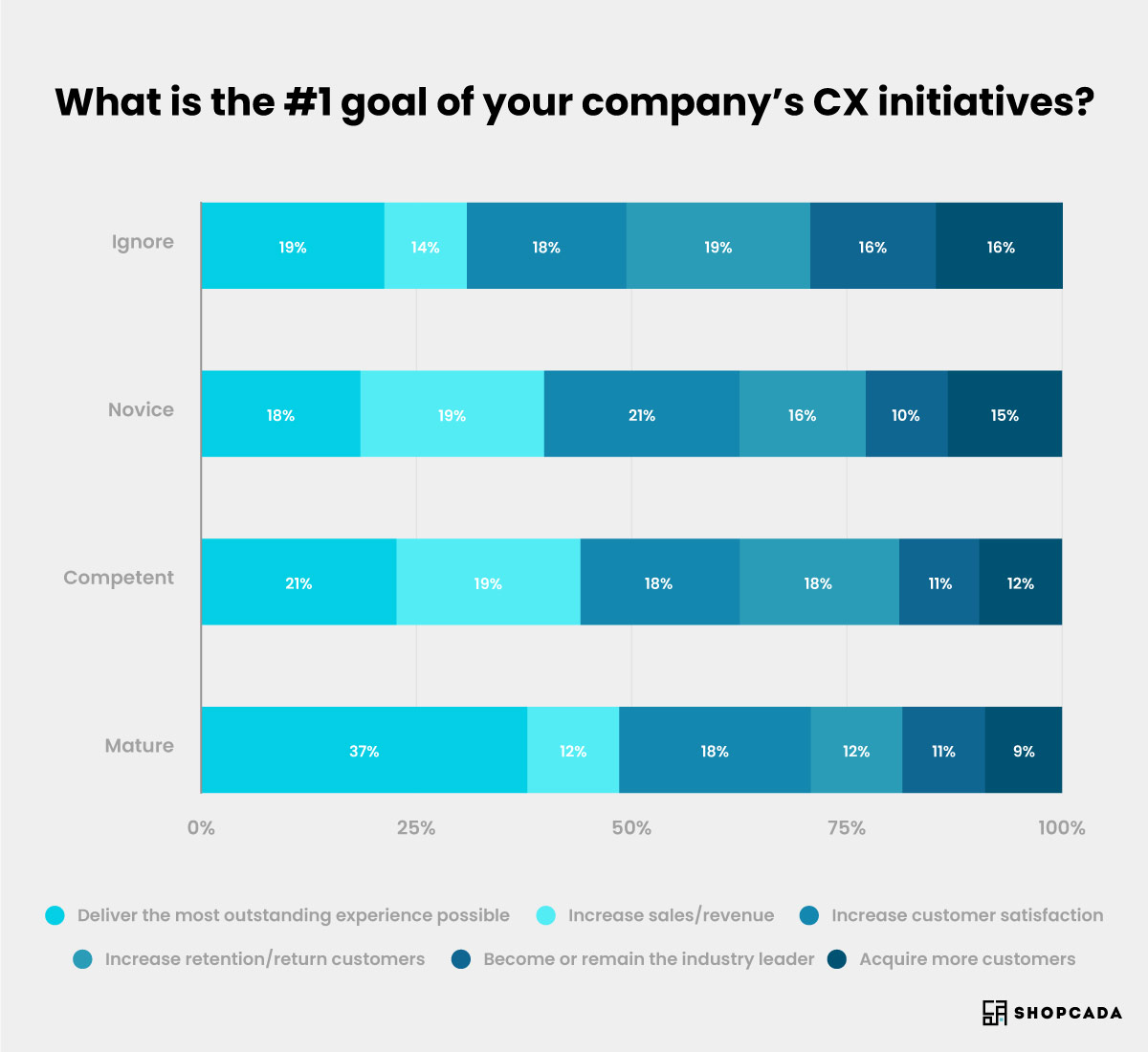
According to 37% of Mature organisations, providing the best possible experience is the top priority of their CX activities, compared to 21% of Competent companies, 18% of Novice companies, and 19% of ignored firms.
As maturity levels rise, the emphasis on recruiting additional consumers diminishes. Only 9% of Mature businesses picked it as their primary aim, compared to 12% of Competent businesses, 15% of Novice businesses, and 16% of ignored businesses.
Increasing sales and revenue was also a lower priority for Mature firms, with just 12% picking this as their primary aim, compared to 19% of Competent and Novice companies and 14% of ignored organisations.
Customer experience professionals rely on 'old-school' means
Companies with effective CX initiatives stress 'old-school' tactics like communicating directly to consumers, bringing in the finest people, and conducting market research far more than their less successful peers.
In fact, over two-thirds of mature firms depend on these strategies as the most effective ways to implement their CX strategy.
And, unlike their less successful peers, they depend significantly less on 'over-hyped' technologies such as chatbots, predictive analytics, and augmented reality.
In other words, mature businesses avoid being distracted by 'shiny' items and instead focus on what they know will generate results.
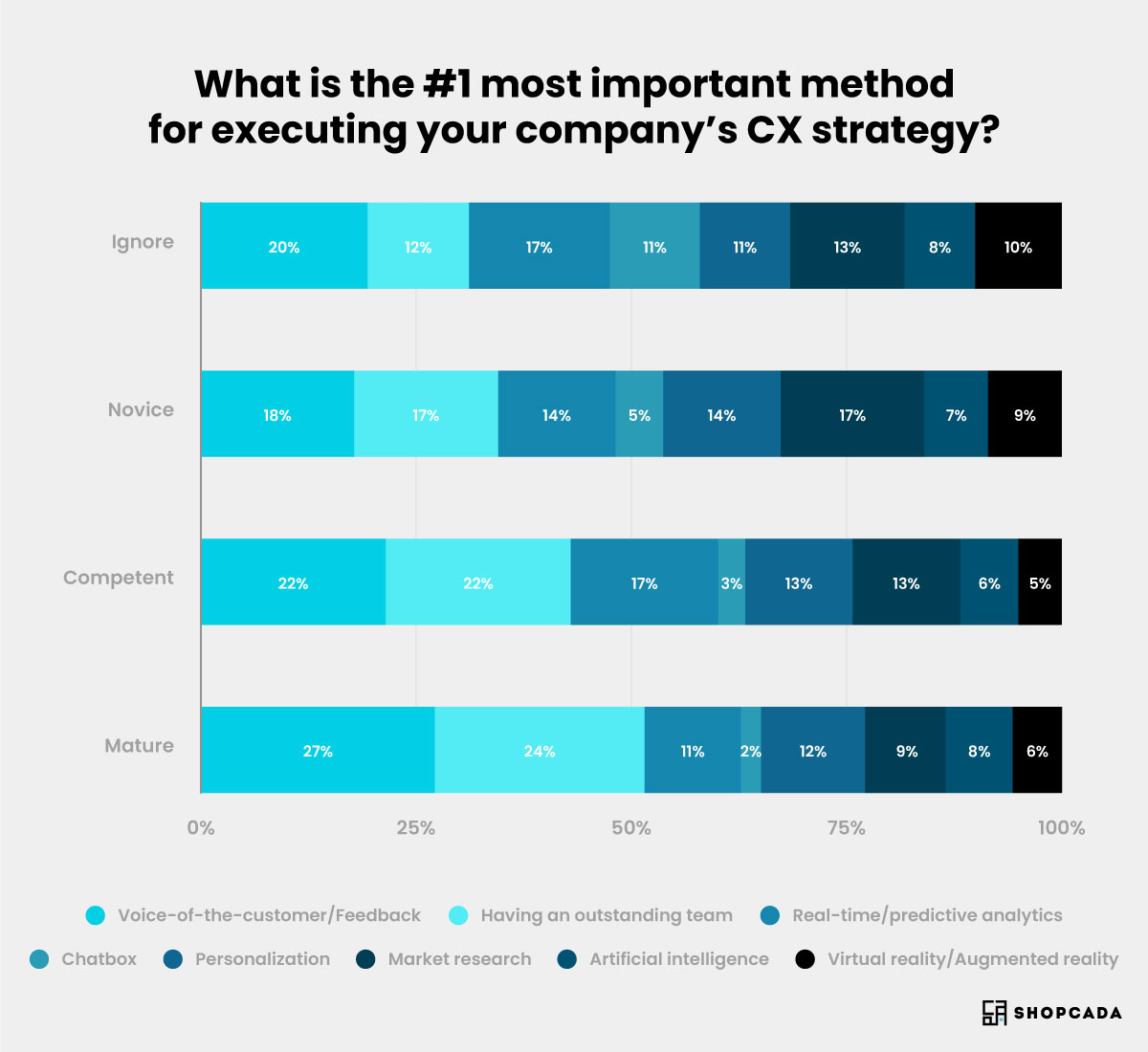
While voice-of-the-customer (VOC) input was the most popular option across the board, it was chosen as the top way by 27% of Mature firms, 22% of Competent companies, 18% of Novice companies, and 20% of ignored organisations.
Mature businesses also emphasised having an amazing team far more than the rest, with 24% vs 22% for Competent businesses, 17% for Novice businesses, and just 12% for Ignorant businesses.
Very few Mature companies were found to have prioritised chatbots (2%) and predictive analytics (11%) when compared to Competent companies (3% and 17%), Novice companies (5% and 14%), and Ignorant companies (11% and 17%).
Now, that is all nice and well, but at this point, it seems to be very much about giving good customer service, no?
Customer Service VS Customer Experience
In summary, customer service is only one component of the overall customer experience.
Customer experience, as previously said, is a customer's total view of your organisation based on their encounters with it. Customer service, on the other hand, refers to particular touchpoints within the experience when a customer wants and receives support or help—for example, phoning an operator to request a refund or communicating with a service provider via email.
In other words, customer experience is more important than customer service. It encompasses every interaction a consumer has with your organisation, from the first time they hear about you in a blog post they found on Google until the time they phone your customer support staff to complain about your product.

What Makes A Good Experience?
There is no single universal checklist to follow to ensure a positive customer experience: your company is unique, as are your consumers. However, after surveying 2000 CX professionals from various businesses, we discovered several similar concepts. The complete findings of our poll can be seen here, but we've highlighted some of the important insights below.
In summary, you may provide an excellent client experience if you:
-
Make listening to consumers a major priority throughout the organisation.
-
Utilise client feedback to gain a thorough understanding of your consumers.
-
Create a system to help you gather input, evaluate it, and act on it regularly.
-
Reduce friction by addressing your consumers' issues and concerns.
A successful customer experience is the result of asking your consumers questions, listening to their replies, and acting on their feedback.
What strategies are businesses most reliant on to better understand their customers?
Client surveys and customer calls are the most popular tools for Mature, Competent, and Novice businesses to better understand individual consumers.
Ignorant firms, on the other hand, tend to put more effort into live chats and social media than any other maturity level.
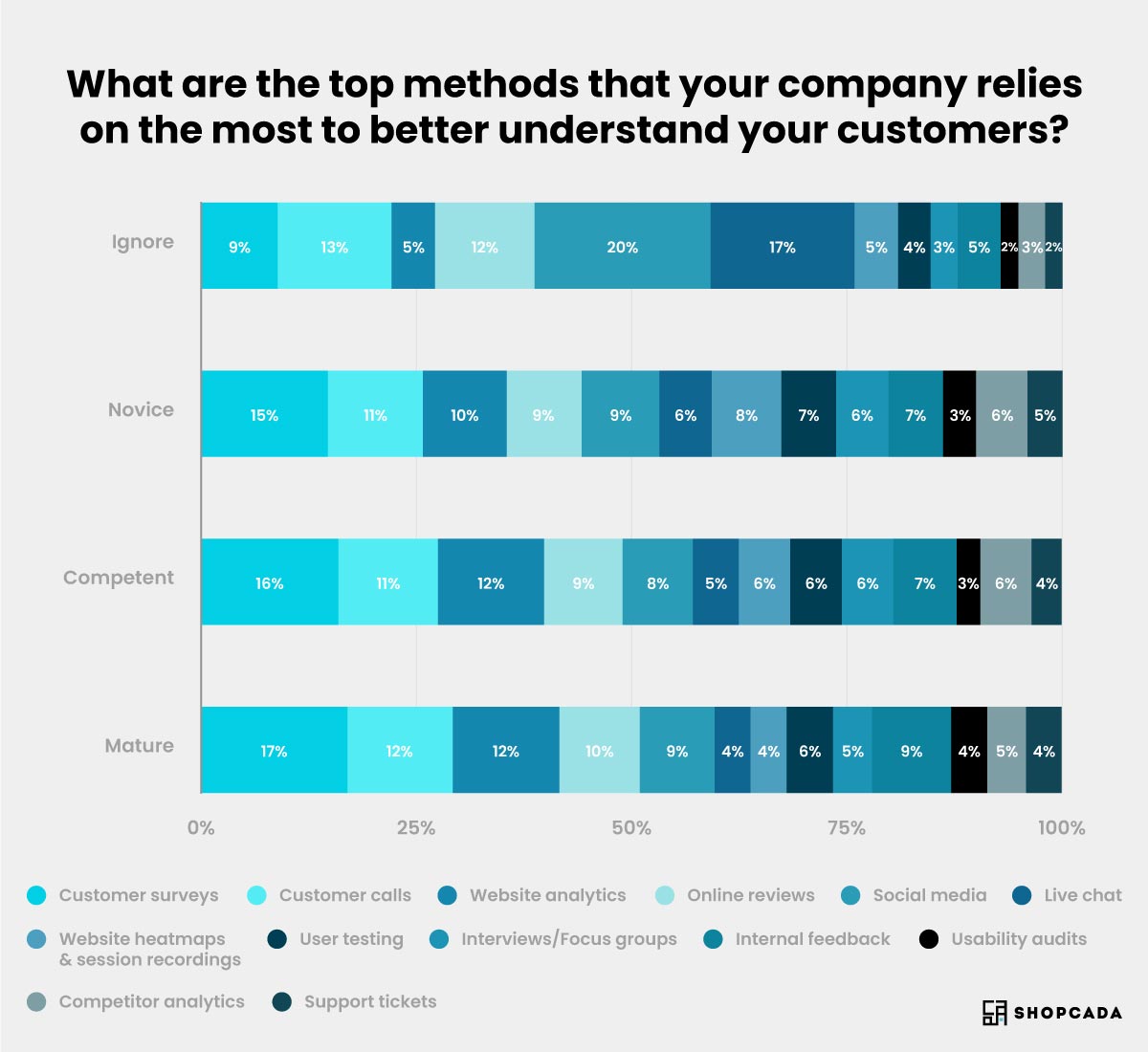
Customer surveys were the most popular strategy, used by 17% of Mature firms, 16% of Competent companies, 15% of Novice companies, and 9% of ignored companies.
Customer service and website analytics came as a close second, with 10-12% of Mature, Competent, and Novice businesses choosing these two.
Social networking (20%) and live chat (17%) are the most important channels for Ignorant businesses. That is double the importance that other firms place on social media and five times the importance that other organisations place on live chat.
Pro-tip: These more engaging forms of communication with your customers can help them feel part of a community which contributes to building the brand and gives them a form of validation that their comments and/or ideas are heard by you!
What Constitutes Bad CX?
A bad customer experience can take many forms, but we discovered several regularly mentioned concerns in our customer experience statistics.
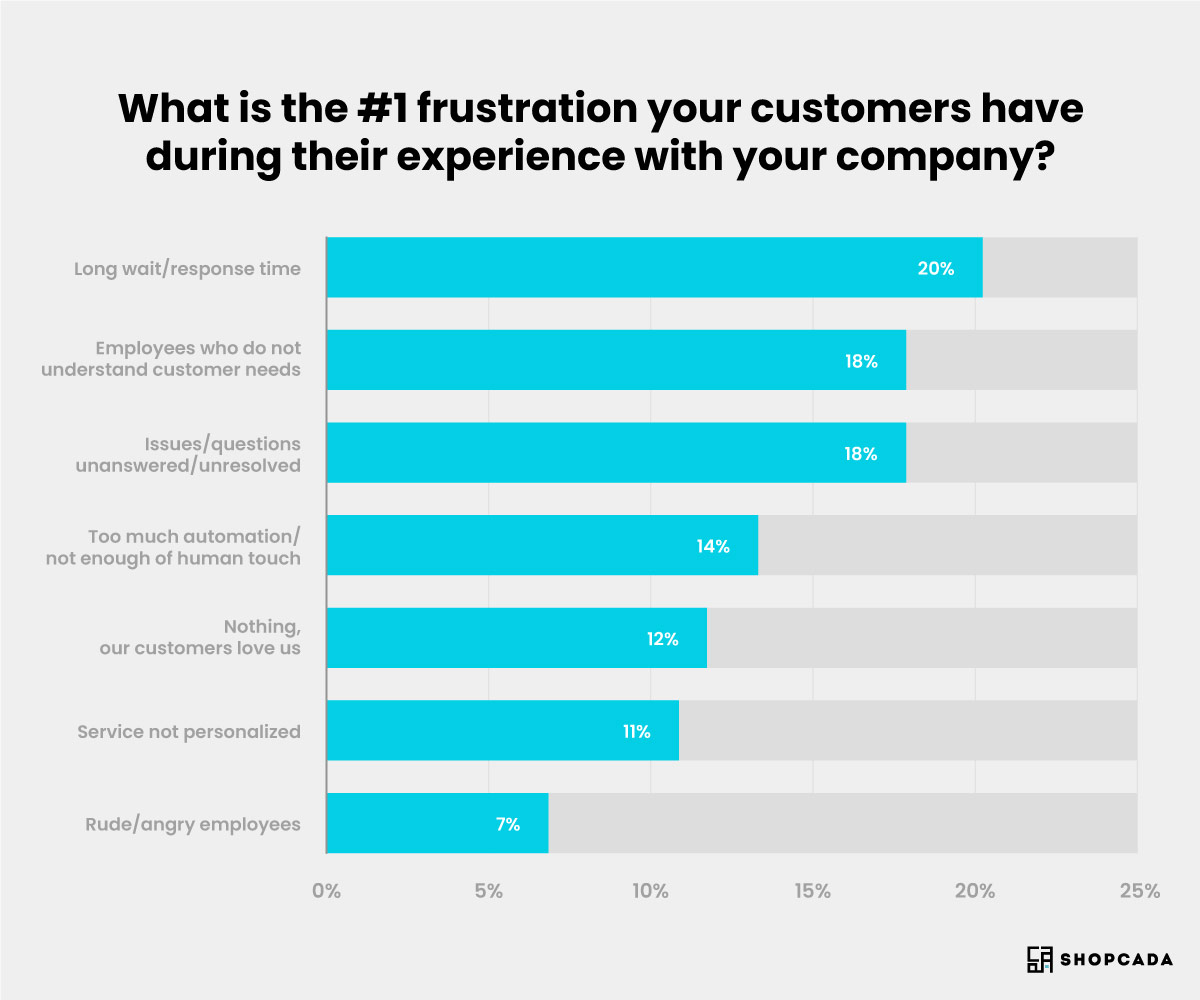
Poor customer service is largely caused by:
-
Long waiting periods
-
Employees that do not comprehend the demands of their customers
-
Unresolved problems/questions
-
Too much automation/insufficient human touch
-
Service that is not customised
-
Employees that are rude/angry
If you need additional ideas, consider the last time you were dissatisfied as a customer—quite it's probable that one (or more) of the above was the cause.
However, what constitutes terrible customer experiences in your organisation will be unique—and you'll only learn about it by inviting customer input and then trying to reduce the influence of elements that generate a negative experience for your customers.
Using Customer Feedback
You may understand the theory behind what constitutes excellent and bad CX, but for it to have an impact on your business, you must have a dependable means of gathering feedback from your consumers so that you can act and make meaningful changes.
Customer feedback is information gathered from consumers regarding their interactions with your product, service, website, or company as a whole. This input may be used to improve the
customer experience by removing or lowering sources of friction and enhancing positive touchpoints.
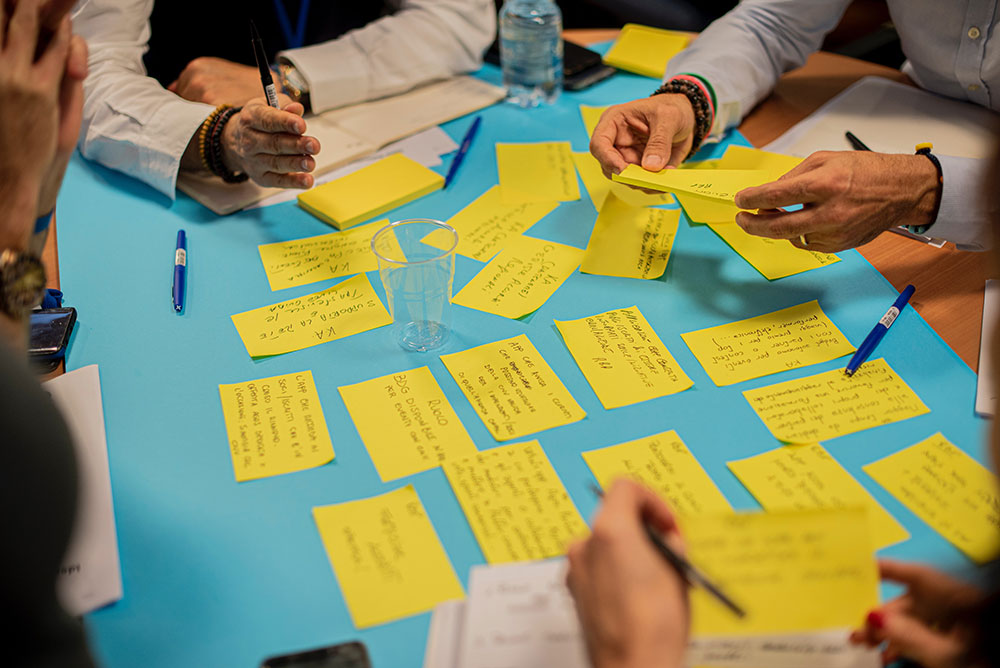
Without realising it, you're probably already collecting client feedback: when a consumer writes an email, contacts customer service, or leaves a review, that's feedback. The difficulty is that if that input isn't monitored and analysed, you're passing up an opportunity to improve customer experience and capitalise on its growth potential.
Customer Experience Analysis
According to what we've said so far, customer experience appears to be a subjective idea that is tough to quantify. As a result, you must rely on a variety of CX indicators, which may be used alone or in combination to provide an indication of customer experience in your firm.
With a measurable indication of customer experience, you can watch how it improves (or worsens) over time and use it to assess the success or failure of changes you make that may affect your consumers. Here are the four most important KPIs that CX specialists use to measure client experience over time:
Customer Effort Score (CES)
Customer Effort Score assesses your customers' experience with a product or service by determining how 'tough' or 'simple' it is for them to act.
CES surveys are typically handed out following a customer service engagement, with questions such as 'How simple was it to have your issue fixed today?' as well as a grading system ranging from "1: very tough" to "7: very easy." They also perform effectively when clients have reached significant milestones in their journey (for example, after they sign up for a free product trial or after they successfully concluded a transaction).
Net Promoter Score (NPS)
Net Promoter Score is a customer loyalty score calculated by asking consumers a simple closed-ended question: "How likely are you to suggest this product/company to a friend or colleague on a scale of 0 to 10?"
You may modify the question somewhat to better suit your business and use a follow-up NPS inquiry to gain further information, but the goal of NPS is to obtain a simple numerical score on a range of 0 to 100 that measures customer experience.
Customer Satisfaction Score (CSAT)
CSAT surveys assess your consumers' satisfaction with the products or services you provide. They can be represented on a 5- or 7-point scale (where 1 represents highly dissatisfied and 7 represents very satisfied), or as binary yes/no responses.
Unlike the Net Promoter Score, which encourages customers to examine their overall feelings toward the brand (and consequently their likelihood of recommending it or not), CSAT focuses on individual touchpoints with which they were happy or unsatisfied.

Time To Resolution (TTR)
TTR is the average time it takes customer care teams to address an issue or ticket that a customer has raised. It is computed by summing all times to resolution and dividing the result by the number of cases solved. It can be measured in days or business hours.
A long wait/response time was discovered to be the primary source of consumer frustration. TTR is an important indicator to watch and improve in this regard: the shorter your TTR, the less likely your clients will be frustrated when they contact you for assistance.
Closing Words
Identifying critical contact points throughout your customers' journeys, gathering customer feedback to enhance or continue iterating on those experiences, and monitoring patterns can help you boost consumer sentiment about your brand – and keep them telling their friends and family about it.
Sidenote, Net Promoter, Net Promoter System, NPS, and NPS-related emoticons are registered trademarks of Bain & Company, Inc., Fred Reichheld, and Satmetrix Systems, Inc.
More articles please read Customer Data Platforms: Your Simple Starter Guide

